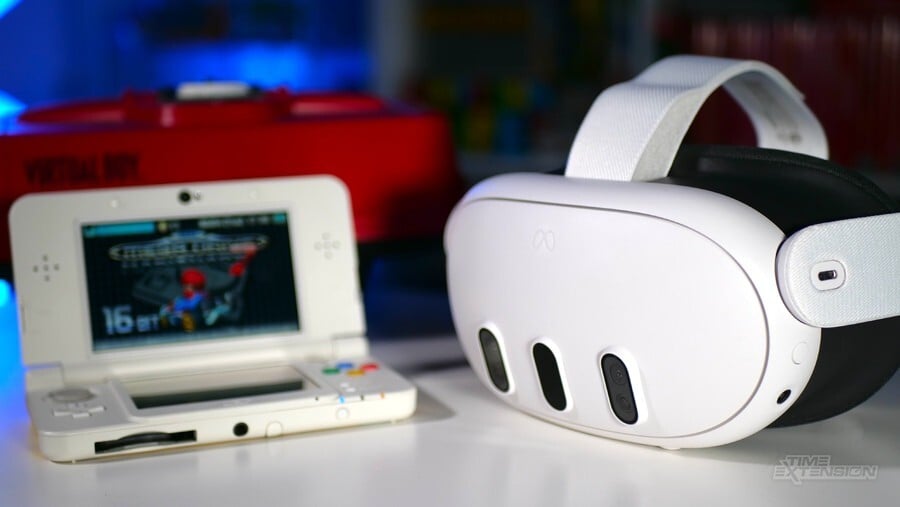
Nintendo's recent closure of the 3DS eShop has presented something of a quandary for fans of the console and video game preservationists in general: how do you accurately preserve systems which have technical quirks that are impossible to replicate on your average console, PC or handheld?
The 3DS offers autostereoscopic visuals which convincingly present three-dimensional depth, and while pretty much every 3DS title is perfectly playable without this feature (hence the release of the 2DS), it remains an intrinsic part of the console's appeal. While there are a great many 3DS consoles out in the wild, there will come a time when obtaining one might prove costly, so what possible way is there to ensure the system's innovative 3D effect can still be enjoyed?
That was something I was personally pondering when I heard the news that the 3DS emulator, Citra, had been ported to the Meta Quest 3. The benefits didn't need any explanation; because the VR/AR headset is capable of presenting 3D depth, reproducing the 3DS' visuals is simple. Even so, this didn't prepare me for the sheer impact of experiencing these games again in a totally new way. In short, playing 3DS games on the Meta Quest 3 feels so natural and immersive that it's making me curse Nintendo for not doing something similar beforehand.
In fact, the Meta Quest 3 (and its predecessor, the Quest 2) is already a great way to experience another of Nintendo's experiments with 3D visuals – the ill-fated Virtual Boy. Released in 1995 to consumer apathy, it has gone down as the Japanese company's most costly commercial blunder, yet playing its games via the VirtualBoyGo emulator on the Meta Quest 3 is a transformative experience – even for someone like myself who owns an original Virtual Boy and has spent many headache-inducing hours craned over a desk playing it.
Citra running on the Quest 3 delivers something new and different, however, because it allows you to play in 'passthrough' mode so you can still view your real-world surroundings. Apple has coined this approach 'spatial computing', where you're able to have multiple 'virtual screens' dotted around the room. As Mark Zuckerberg has been keen to point out recently, the Meta Quest 3 can do this as well (and at a fraction of the price), but outside of work, it's a great way to play 3DS games without having to cut yourself off from the world. In Citra – which is still in beta, I should note – you can reposition the top and bottom screens, as well as enlarge the uppermost screen for a more immersive view of the action.
Games that previously looked impressive on the 3DS' tiny autostereoscopic screen are now capable of filling your entire field of view, and while the graphics are dated compared to modern-day VR titles, the experience is often overwhelming; it's almost as if 3DS games have been given a next-gen upgrade when played in this way (it's actually possible to upscale the games in the emulator, too). Mario Kart 7 becomes more exciting thanks to the convincing sense of depth and speed, while Zelda: A Link Between Worlds gives the impression that you're gazing down into a doll's house while the characters move around within it. I wish I could accurately show what this looks like, but, as was always the case with the 3DS, you have to experience it to get the full impact.
Given that it's in beta, there are some caveats to consider with Citra. Performance can be spotty, with regular pauses and skips – this will hopefully improve over time. Compatibility is also something of an issue, at least for me personally; some games don't currently boot, while others (such as SEGA 3D Classics Collection) load the game's main menu fine but won't load up any of the games. It's clearly going to get much better than this, but there are already some features which really impress me, such as the ability to connect a Bluetooth controller and use that instead of the (actually perfectly fine) Meta Quest 3 controllers.
Outside of Nintendo's machines, we're already seeing the Meta Quest 3 become a surprisingly fertile playground for old-school gamers. People are recreating the amusement arcades of their youth (complete with playable machines), while EmuVR – which sadly isn't yet native to Quest 3 (yet) and requires the use of a computer – delivers a similar experience but with the added benefit of netplay and the ability to experience light gun games in VR.
Given the cost of amassing a sizeable 3DS and Virtual Boy collection today, would I advise people to stick with original hardware when such a compelling alternative exists? Given that Nintendo doesn't offer official access to its Virtual Boy library and has recently shuttered the 3DS eShop, there's definitely a solid argument to say that you're better off experiencing both of these platforms via a VR device like the Meta Quest 3 – especially as it allows you to enjoy their 3D magic in the most convincing way imaginable.





